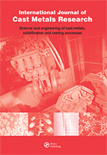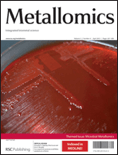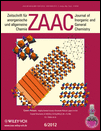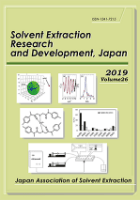
BIOMETALS
Scope & Guideline
Exploring the Intersection of Metals and Life
Introduction
Aims and Scopes
- Metal Toxicology and Biochemistry:
Research on the effects of toxic metals (like cadmium, lead, arsenic) on biological systems, including mechanisms of toxicity and cellular responses. - Metal Homeostasis and Nutrition:
Studies investigating how essential metals (such as zinc, iron, copper) are regulated within biological systems and their role in nutrition and health. - Biometal Applications in Medicine:
Exploration of biometals in therapeutic contexts, including drug development, treatment of diseases, and their roles in antimicrobial and anticancer therapies. - Environmental Impact of Metals:
Research on the environmental presence of metals, their bioaccumulation, and effects on ecosystems, as well as strategies for bioremediation. - Nanotechnology and Metal-Based Materials:
Studies on the synthesis, characterization, and applications of metal nanoparticles in various fields, including agriculture, medicine, and environmental science.
Trending and Emerging
- Metal-Drug Interactions and Therapeutics:
A rising trend in exploring how metals can enhance or modify the efficacy of existing drugs, including studies on metal complexes with anticancer properties. - Metallomics and Systems Biology:
Emerging interest in metallomics, which studies metals in biological systems at a holistic level, integrating metal biology with genomics and proteomics. - Green Synthesis of Metal Nanoparticles:
Increased focus on environmentally friendly methods for synthesizing metal nanoparticles, emphasizing sustainability and potential applications in medicine and agriculture. - Role of Metals in Viral Infections:
Growing research into how metal ions influence viral pathology and their potential roles in antiviral therapies, particularly in the context of COVID-19. - Bioremediation and Metal Recovery:
Innovative approaches to bioremediation using biological systems to recover or detoxify heavy metals from contaminated environments, reflecting a broader environmental consciousness in research.
Declining or Waning
- Heavy Metal Accumulation in Plants:
While still a relevant topic, the frequency of studies solely focused on plant metal accumulation and its effects has diminished, possibly due to a broader focus on integrated bioremediation strategies. - Traditional Metal Chelators:
Research on classical metal chelators, like EDTA, appears to be waning as newer, more efficient chelation strategies and biogenic alternatives gain traction in the field. - Basic Metal Toxicity Studies:
Although foundational studies on metal toxicity remain important, there seems to be a decline in purely descriptive studies without mechanistic insights, as the field shifts towards understanding complex interactions and applications. - Animal Models for Metal Exposure Studies:
The use of traditional animal models for studying metal toxicity is decreasing, with a gradual shift towards in vitro or computational models that may offer more controlled and ethical research environments.
Similar Journals

INTERNATIONAL JOURNAL OF CAST METALS RESEARCH
Fostering Collaboration for Future Metal InnovationsInternational Journal of Cast Metals Research, published by Taylor & Francis Ltd, serves as a premier platform for the dissemination of cutting-edge research in the fields of Mechanical Engineering, Mechanics of Materials, and Metals and Alloys. With a commitment to advancing the understanding of cast metals, this peer-reviewed journal has achieved notable recognition, featuring a 2023 Q2 ranking in its respective categories and ranking 71st in the Materials Science field according to Scopus. Researchers and professionals will find a wealth of valuable insights through rigorous studies and innovative findings, reflecting the journal's goal of facilitating knowledge transfer and addressing contemporary challenges in material science. Furthermore, its accessible publication years from 1996 to 2024 ensure that it not only captures the evolution of technology in cast metals but also stands at the forefront of future developments. Ideal for academics and practitioners alike, the journal aims to foster collaboration and inspire new developments within the discipline.

TRANSITION METAL CHEMISTRY
Advancing Knowledge in Transition Metal ScienceTransition Metal Chemistry is a distinguished journal published by Springer, focusing on the latest advancements in the field of inorganic chemistry, materials science, and metals and alloys. With an impressive publication history dating back to 1975, this journal serves as an essential platform for researchers and professionals seeking to explore the complexities and innovations in transition metal chemistry. Transition Metal Chemistry holds a Q4 ranking in Inorganic Chemistry and positions itself in Q3 within both Materials Chemistry and Metals and Alloys categories, highlighting its evolving influence in these domains. With a Scopus ranking of #41 in Inorganic Chemistry and #56 in Materials Science, it provides readers with valuable insights into research trends and discoveries. Although it does not offer open access, its rigorous peer-review process ensures that only the most impactful and validated studies are published. By bridging theoretical concepts and practical applications, Transition Metal Chemistry plays a pivotal role in advancing scientific knowledge, attracting a diverse audience of researchers, students, and industry professionals committed to unraveling the complexities of transition metals.

METALLURGIST
Illuminating the Path of Metallurgical Excellence.METALLURGIST, published by SPRINGER, is a distinguished journal dedicated to advancing the field of metallurgy and materials science. With a rich history dating back to 1957, this journal serves as an essential platform for disseminating cutting-edge research encompassing a wide scope of topics, including condensed matter physics, materials chemistry, and the mechanics of materials. The journal's impact can be seen through its categorization in the Q4 and Q3 quartiles across various fields, indicating its significance in the global research landscape. Although it is not an open-access publication, METALLURGIST maintains high academic standards and attracts contributions that provide valuable insights into metals and alloys, offering researchers and professionals a wealth of knowledge that is pivotal for innovative developments in the materials sector. With its continued commitment to excellence, METALLURGIST aims to foster collaboration and engagement within the metallurgical community, making it a vital resource for students, researchers, and industry experts alike.

REVIEWS IN INORGANIC CHEMISTRY
Empowering Researchers with Invaluable InsightsREVIEWS IN INORGANIC CHEMISTRY, published by Walter de Gruyter GmbH, is a distinguished academic journal that serves as a vital resource for researchers, professionals, and students within the field of inorganic chemistry. With its ISSN 0193-4929 and E-ISSN 2191-0227, this journal has made a significant impact on the discipline, holding a commendable Q2 ranking in the 2023 category of Inorganic Chemistry, placing it in the 81st percentile among its peers according to Scopus rankings. Continuously published since its inception, with converged years spanning from 1985 to 1990 and 1992 to 2024, it features comprehensive reviews encompassing the latest advancements, methodologies, and theoretical frameworks in the subject. Researchers will find IDEAL insights and valuable discussions that keep them abreast of trends and challenges in the domain, essential for driving innovation and collaboration. The journal’s commitment to quality and rigorous peer review highlights its importance in advancing inorganic chemistry research, making it an indispensable tool for academic excellence.

JOURNAL OF BIOLOGICAL INORGANIC CHEMISTRY
Advancing Insights into Inorganic Elements in Biology.JOURNAL OF BIOLOGICAL INORGANIC CHEMISTRY, published by Springer, serves as a pivotal platform for the dissemination of research that intersects the fields of biochemistry and inorganic chemistry. With a commitment to advancing our understanding of the intricate roles that inorganic elements and compounds play in biological systems, this journal addresses a diverse array of topics from metal ion interactions in biological processes to the design of biomimetic systems. Hailing from Germany and reaching a global audience, it has maintained a distinguished status in its field, achieving a Q2 ranking in Inorganic Chemistry and a Q3 ranking in Biochemistry as of 2023, reflecting its impactful contributions to the scientific community. Although currently not open access, the journal provides vital insights that are essential for researchers, professionals, and students alike, promoting knowledge and collaboration in a rapidly evolving scientific landscape. With an expansive range of articles published since 1996, the JOURNAL OF BIOLOGICAL INORGANIC CHEMISTRY continues to be an indispensable resource for anyone working at the intersection of chemistry and biology, especially in understanding the biochemical implications of inorganic substances.

Metallomics
Decoding the Role of Metals in Living SystemsMetallomics, published by Oxford University Press, is an esteemed journal with an ISSN of 1756-5901 and an E-ISSN of 1756-591X, specializing in the interdisciplinary field of metallomics—a critical area that examines the role of metals in biological systems. With a strong ranking in its categories, notably achieving Q1 status in Metals and Alloys and Q2 across fields such as Biochemistry, Biomaterials, Biophysics, and more, the journal serves as a pivotal resource for researchers, professionals, and students alike, facilitating cutting-edge discussions and discoveries. The journal's rigorous selection process ensures that only high-quality research is published, maintaining its reputation within the scholarly community. Despite lacking an Open Access option, its significant impact is reflected in its Scopus rankings, where it ranks 32nd in Materials Science and 21st in Chemistry (miscellaneous), emphasizing its influence and relevance. Metallomics invites submissions that contribute to the understanding of metal interactions in biological contexts, proposing new methodologies and insights that can shape future research in this dynamic and essential field.

ZEITSCHRIFT FUR ANORGANISCHE UND ALLGEMEINE CHEMIE
Fostering Collaboration in Chemical ResearchZEITSCHRIFT FUR ANORGANISCHE UND ALLGEMEINE CHEMIE, published by WILEY-V C H VERLAG GMBH, is a pivotal journal in the field of inorganic chemistry, catering to the needs of researchers, professionals, and students seeking to advance their understanding of this dynamic discipline. With its historical roots dating back to 1892 and a commitment to high-quality research, this journal provides a platform for the dissemination of significant findings related to inorganic substances and their general chemistry. Although currently not an open-access journal, it holds a competitive position with an impact factor placing it in the Q3 quartile of the Inorganic Chemistry category, ranking #57 out of 79 in Scopus. Situated in Germany, this journal not only connects past and present research endeavors but also aims to foster innovation and collaboration within the inorganic chemistry community. Whether you are exploring fundamental concepts or groundbreaking applications, ZEITSCHRIFT FUR ANORGANISCHE UND ALLGEMEINE CHEMIE remains an invaluable resource for advancing chemical sciences.

ZEITSCHRIFT FUR NATURFORSCHUNG SECTION B-A JOURNAL OF CHEMICAL SCIENCES
Elevating Chemical Research with Quality and IntegrityZEITSCHRIFT FUR NATURFORSCHUNG SECTION B-A JOURNAL OF CHEMICAL SCIENCES is a distinguished scholarly journal published by Walter de Gruyter GmbH, based in Berlin, Germany. Since its inception in 1947, this journal has served as a vital platform for the dissemination of innovative research and findings in the field of chemical sciences. With an ISSN of 0932-0776 and E-ISSN of 1865-7117, it is indexed in prominent databases, reinforcing its credibility and accessibility for researchers and professionals alike. Currently categorized in the third quartile (Q3) in the field of miscellaneous chemistry according to 2023 assessments, it holds a significant position in the landscape of chemical research, ranking 270th out of 408 in general chemistry with a percentile standing of 33%. Although not an Open Access publication, its rigorous peer-review process ensures the publication of high-quality articles that contribute to advancing knowledge and innovation in chemistry. The journal’s commitment to scientific excellence makes it an essential resource for students and professionals seeking to stay updated with the latest developments in chemical sciences.

RUSSIAN JOURNAL OF COORDINATION CHEMISTRY
Exploring the Nexus of Metal and MoleculeThe Russian Journal of Coordination Chemistry, published by Pleiades Publishing Inc, stands as a significant contribution to the field of coordination chemistry, focusing on the intricate relationships between metal ions and organic molecules. With an ISSN of 1070-3284 and an E-ISSN of 1608-3318, this journal has been curating high-quality research since its inception in 1996. Though it currently does not offer open access, the journal plays a crucial role in disseminating innovative findings, evidenced by its Q3 ranking in both Chemical Engineering and Chemistry categories as of 2023. With Scopus rankings placing it in the 40th percentile among general chemistry and chemical engineering journals, it demonstrates a commitment to advancing knowledge in these vital areas. The journal invites researchers, professionals, and students alike to engage with its comprehensive articles that explore both theoretical and practical aspects of coordination chemistry, supporting the development of new applications and techniques within the field.

SOLVENT EXTRACTION RESEARCH AND DEVELOPMENT-JAPAN
Innovating chemical processes through expert research.SOLVENT EXTRACTION RESEARCH AND DEVELOPMENT-JAPAN is a prominent journal dedicated to advancing the field of solvent extraction and its applications in chemical engineering and general chemistry. Published by the Japan Association for Solvent Extraction, this journal plays a crucial role in disseminating innovative research findings, technical advancements, and comprehensive reviews pertinent to solvent extraction processes and technologies. With a publication history dating back to 1996 and extending through 2024, it serves as a vital resource for academics, industry professionals, and students alike. Although it currently does not offer open access, the journal provides invaluable insights into solvent extraction which can enhance both theoretical knowledge and practical applications in various industries. Its Scopus rankings indicate a competitive presence in the field, making it an essential read for anyone engaged in chemical engineering research. The journal is accessible via its office located at Professor Kenichi Akiba's residence at the University of Kitakyushu, and it invites contributions from researchers aiming to elevate the understanding and efficiency of solvent-based methodologies in chemical processes.